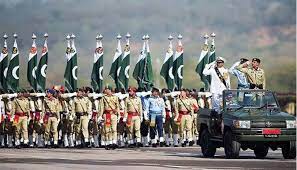Muhammad Aftab Alam
Pakistanis celebrate Defence Day on September 6 every year as a national day to commemorate the sacrifices offered by Pakistani soldiers on the altar of defending the borders of its motherland. However, the day also has special significance for commemorating the life-long struggle of countless individuals and organizations working round the clock in an endeavor of making the defense of this country impregnable.
Pakistan Atomic Energy Commission (PAEC) is one such organization that is teeming with numerous unsung heroes who deserve recognition on this day of national pride. Having made the defense of Pakistan invincible on May 28, 1998, PAEC has now developed into the topnotch Research and Development (R&D) organization of the country. Besides, PAEC has also assumed the lead role in efforts to ensure sustainable development of the country in all spheres of life.
According to United Nations (UN): “The 2030 Agenda for Sustainable Development, adopted by all UN Member States in 2015, provides a shared blueprint for peace and prosperity for people and the planet, now and into the future. At its heart are the 17 Sustainable Development Goals (SDGs), which are an urgent call for action by all countries – developed and developing – in a global partnership.
They recognize that ending poverty and other deprivations must go hand-in-hand with strategies that improve health and education, reduce inequality, and spur economic growth – all while tackling climate change and working to preserve our oceans and forests.”
PAEC is making a steady progress in achieving 11 out of the 17 Global Goals or SDGs on national level by using nuclear technology for peace and prosperity. Among these goals, ‘SDG-7: Affordable and Clean Energy’ is crucially important, as many areas of national growth are directly dependent on it. PAEC is diligently striving to meet the target set by the government of producing 8,800 megawatt (MW) of nuclear power by 2030 and 40,000 MW by the year 2050, for the country.
In this connection, the groundbreaking of the country’s largest Nuclear Power Plant (NPP) was performed on July 14, 2023 in a step towards making nuclear energy the key source of power in the energy mix of the country. The 1200 MW Chashma-5 NPP will start generating electricity by 2030.This year, PAEC also gifted the nation with a 1100 MW of clean, reliable and cost-effective electricity by inaugurating the much-awaited Karachi Nuclear Power Plant Unit-3 (K-3).in a giant leap to revolutionize the energy sector of the country.K-2 and K-3 are the maiden Generation-III NPPs in Pakistan with generation capacity of 1100 MW each and their addition to the national grid has contributed in reducing load shedding especially during summers.
Inauguration of K-3 is a memorable moment for Pakistan and its civil nuclear power program. It is the result of collaborated and continuous efforts of PAEC and China National Nuclear Corporation (CNNC), which culminated in a successful nuclear power program for Pakistan. The history of Pakistan’s civil nuclear power program goes back to 1965 when construction of the first NPP namely Karachi Nuclear Power Plant (KANUPP) of 137 MW capacity commenced in Karachi. KANUPP started supplying electricity to national grid in 1972 and has now successfully entered the decommissioning phase after successful operation of over 5 decades.
Since then, PAEC has so far constructed four Nuclear Power Plants at Chashma with the assistance of China. These plants have total generation capacity of 1330MW.The first plant of Generation-III technology, Karachi Nuclear Power Plant Unit-2 (K-2) went into commercial operation on 21st May, 2021. Both K-2 and K-3 possess evolutionary design with improvements based on rich experience and extensive Tests and Analyses satisfying National and International Safety Codes, Standards and Practices.
All six NPPs of Pakistan, including K-2 and K-3, are under International Atomic Energy Agency (IAEA) safeguards. As far as efficiency of the PAEC-operated NPPs is concerned, Pakistan’s Chashma Nuclear Power Plant Unit-2 (C-2) made a national record in the country’s history in 2020 by running for a year continuously, becoming the second electricity generation plant of the country to achieve this milestone.
Previously, Chashma Nuclear Power Plant Unit-4 (C-4) had made the record of running for continuous 365 days, on July 1, 2020.These records of efficient and safe operations speak volumes of the acumen and hard work of PAEC’s teams of technicians, scientists and engineers. Currently, Chashma Power Plants (C-1 to C-4) are operating at above 95% of Capacity Factor.
PAEC gives highest priority to the Safety and Security of its nuclear installations and that is why it has adopted “Safety First” as a slogan for the nuclear power plants. PAEC is cognizant of the fact that a country requires affordable and reliable energy to prosper. Pakistan’s Nuclear Power Program is an important component of our quest for reliable, cost-effective and clean energy with zero carbon emission. Nuclear Power Program can also contribute significantly in mitigating effects of the climate change thus helping the country achieve ‘SDG-13: Climate Action’.
Furthermore, PAEC power plants also play an important role in the uplift of surrounding areas by improving infrastructure, creating jobs, imparting education and providing modern health facilities thus covering other SDGs. Nearly 75% employees working in Chashma are locals. Similarly, K-2/K-3 projects have given employment to over 2,000 skilled local workers.
In its quest to achieve ‘SDG-3: Good Health and Well-Being’, PAEC has so far established 20Atomic Energy Cancer Hospitals (AECHs) sited in all provinces and major cities of the country. Gilgit Institute of Nuclear Medicine, Oncology and Radiotherapy (GINOR) sited in Gilgit and Diagnostic Centre in Narowal (DCN) are the latest addition, while the construction of 21stAECH has also commenced in Muzaffarabad. These hospitals are providing diagnostic and therapeutic facilities to Cancer patients at subsidized rates by dint of support from Patient Welfare Society (PWS) of the hospitals and Pakistan Bait-ul-Mal (PBM).
Nuclear Medicine, Oncology & Radiotherapy Institute (NORI) in Islamabad whereas KIRAN in Karachi and INMOL in Lahore, are among the flagship cancer hospitals being run by PAEC. Role of these 20 hospitals in the health sector is commendable as over one million cancer patients get diagnostic and treatment facilities at these hospitals every year.
In pursuing’SDG-2: Zero Hunger’, PAEC is also taking lead in utilizing nuclear technology to improve productivity of agriculture sector through the introduction of new crop varieties, pest control technologies, plant nutrition, water management, animal health and productivity and food decontamination and preservation. Four PAEC agriculture research centres have been established in the three provinces of Pakistan having major share of the cultivatable land in the country. Nuclear Institute of Agriculture (NIA) in Tando Jam, Sindh, (1962), was the first such institute.
Nuclear Institute for Agriculture and Biology (NIAB), Faisalabad, Punjab (1972), Nuclear Institute for Food and Agriculture (NIFA), Peshawar, KPK (1982) and National Institute for Biotechnology & Genetic Engineering (NIBGE), Faisalabad, Punjab (1994) were established and have contributed by developing and introducing over one hundred and fifty (150) varieties of different crops.
These centres also have a fair share in human resource development through training courses, workshops and internships, aiming to achieve ‘SDG-4: Quality Education’. Different courses are routinely arranged at these centres every year for hands-on-training of latest techniques and technologies in various fields of agriculture research. These courses equally benefit researchers, students and academia from various research organizations and universities.
NIAB and NIBGE in Faisalabad are also affiliated with Pakistan Institute of Engineering and Applied Sciences (PIEAS). On national as well as international level, PIEAS is the top-ranking university of the country for award of M.Phil and PhD degrees in various disciplines of engineering and other fields related to advancement in science and technology. Besides, Karachi Institute of Power Engineering (KINPOE) and Chasnup Centre of Nuclear Training (CHASCENT) are other two important centres of PAEC established for developing and training of qualified manpower for its NPPs.
Covering ‘SDG-17: Partnerships for the Goals’ and in the sphere of international cooperation and promotion of the culture of sharing and learning from fellow scientists’ research, PAEC started conducting annual meeting of researchers and scientists in Pakistan. A brainchild of the Noble Laureate of Pakistani origin, Dr Abdul Salam, the idea of holding this annual meeting of scientists from all over the world, was adopted by the then Chairman PAEC Munir Ahmad Khan and the successive chairmen of the Commission.
‘International Nathiagali Summer College (INSC) on Physics and Contemporary Needs’ has been organized every year since 1976 at the scenic hill resort of Nathiagali. Throughout its history, the INSC has attracted approximately 1,050 distinguished scientists and speakers, including eight Nobel Laureates, from renowned universities, research centres, and industries in developed nations.
Owing its credit to the untiring efforts of PAEC scientists, technicians and researchers, Pakistan is now an Associate Member of European Organization for Nuclear Research (CERN) and scientists from the country are actively participating in various research activities at CERN and International Atomic Energy Agency (IAEA). Pakistan is also among the highest recipients of IAEA’s technical support.
One hopes that the brilliant achievements by PAEC’s dynamic workforce would continue with reinforcing vigour in the coming years. On this special day, as the nation salutes the brave soldiers, unflinching diligence of contributors to nation’s unconquerable defense also deserves a standing ovation by all and sundry.







